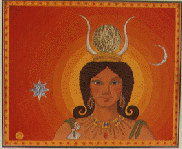ASTARTE
(Mythic - Phoenician)
The Enduring Star
 Called Our Lady of Byblos, Astarte, one of the most ancient Goddesses of the Middle East
is closely identified with the Goddesses Hathor, Ishtar, Aphrodite, Frega, Dande and Irdrani.
Called Our Lady of Byblos, Astarte, one of the most ancient Goddesses of the Middle East
is closely identified with the Goddesses Hathor, Ishtar, Aphrodite, Frega, Dande and Irdrani.
Byblos, the City of the Great Mother, patronized learning and the priestesses of Astarte's temple collected a great library of papyrus scrolls. The Greeks called papyrus byblos which came to mean any holy book (thus, the Bible). According to Egyptian records, as early as 1500 BC, Byblos was a prosperous trading center.
Known as the "Queen of the Stars," Astarte ruled over the spirits who lived in heaven as light, hence stars. Traces of legends abound, relating Astarte to the "Black Virgin" in Syria and Egypt where a virgin birth was celebrated each year late in December. Astarte was frequently referred to as the Heavenly Virgin.
Her image is most frequently seen on ancient seals or reliefs holding the sacred lotus in one hand and two entwined serpents in the other.
SYMBOLS
1. Star - Venus, her aspect as Goddess of Light.
2. Crescent moon - A feminine principle.
3. Cow horns and sun - Crown symbol of Astarte; also, symbol of the Great Mother.
4. Lotus - Universal symbol -- appears with the Great Mother as Lunar Goddess; the flower that was in the beginning; the glorious lily of the great waters. It is the flower of light, the flower being in the form of the sun's rays (flame), it's stem the umbilical cord; it contains creative, generative powers.
5. Papyrus - The merchants of Byblos (early city in Phoenicia) supplied the Greeks and Mediterranean area with papyrus which was used as paper.
Mother of the sun
Daughter of the moon
Ruler of the stars
Keeper of the earth.
In the beginning
Astarte was the whole.
Back